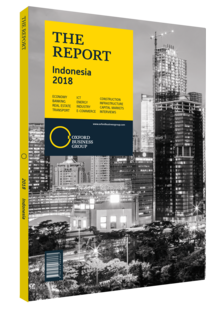Improved fiscal management and oil prices raise Indonesia's bottom line
Authorities have considerably reduced the current account deficit, which fell to historic lows in 2016. Improved fiscal management led to global ratings agency Standard & Poor’s upgrading Indonesia’s sovereign credit rating in May 2017, which should encourage greater capital inflows. Meanwhile, a gradual rise in commodities prices will help balance the books. These higher prices have not extended to the oil and gas sector, further bolstering the outlook. Crude oil price increases could weigh on the account balance, particularly given the decline in domestic production that saw oil output fall by 13.5% between 2009 and 2016.
BALANCE OF PAYMENTS: The country has substantially reined in its current account deficit, which fell to 1.8% of GDP in 2016. This was 0.8% of GDP for the fourth quarter of 2016, the lowest single-quarter level since 2011. This comes after the 2013 deficit peak of 3% of GDP, which occurred amid contracting commodities prices and monetary tightening in the US, prompting capital outflows from dozens of emerging markets.
The balance of payments, which includes current, capital and financial accounts, recorded a $12bn surplus in 2016, equivalent to 1.4% of GDP, against a $1.1bn deficit in 2015. It remained positive in the first quarter of 2017, with Bank Indonesia (BI) reporting a $4.5bn surplus between January and April, supported by large inflows into private currency and deposit assets. Official reserve assets rose from $116.4bn in the fourth quarter of 2016 to $121.8bn at the end of the first quarter of 2017. Equal to an 8.6-month foreign exchange asset reserve cover, this places the country in line with international foreign capital adequacy reserve standards.
BI reported the current account deficit grew to $2.4bn – 1% of GDP – during the first quarter of 2017. This followed a revised 0.9% in the previous quarter, and the figure is expected to increase to 2.4% of GDP in 2017, with anything above 3% considered unsustainable.
ENERGY FLUCTUATIONS: Account improvements are supported by a decline in import values, which fell more sharply than exports throughout 2016, particularly in oil and gas. Indonesia has been a net energy importer since 2003, and its rising fuel bill – coupled with decades of fuel subsidies, which reached 3.7% of GDP in 2012 alone – have weighed on its current account balance.
Average crude oil prices fell from $115 per barrel in June 2014 to less than $50 per barrel at the start of 2016. They have since remained below the $70-per-barrel threshold, with Brent crude around $50 per barrel in mid-2017. The crude oil price decline allowed President Joko Widodo to announce fuel subsidy reductions following his 2014 election victory, worth around $15.6bn.
The energy import bill has also been falling: the Ministry of Trade reported oil and gas imports rose from $42.6bn in 2012 to $45.3bn in 2013, before decreasing to $43.5bn in 2014, $24.6bn in 2015 and $18.7bn in 2016. Oil and gas exports were worth $37bn in 2012, or 19.5% of total export revenues, before falling to $32.6bn in 2013, $30bn in 2014, $18.6bn in 2015 and $13.1bn in 2016. Indonesia had a $5.6bn oil and gas trade deficit in 2016, compared to $12.6bn in 2013, showing the benefits of lower prices on the trade balance.
BENEFITS: In November 2016 the Organisation of the Petroleum Exporting Countries (OPEC), Russia and other major oil producers cut production by 1.8m barrels per day (bpd) for six months from January 2017. This led to a temporary increase in crude oil prices, but they did not exceed $60 per barrel. In May 2017 OPEC agreed to extend the cut by nine months, although concerns about follow-through continued to weigh on prices, with the value of Brent crude dipping below $50 per barrel in the days following the announcement.
While this could reduce earnings, the state budget already projected oil production to decline from 820,000 bpd in 2016 to 815,000 bpd in 2017. Production has fallen from 949,000 bpd in 2009, and subdued global oil prices should prove beneficial with growing population and energy demands. This should maintain a stable balance of payments and long-term growth.
You have reached the limit of premium articles you can view for free.
Choose from the options below to purchase print or digital editions of our Reports. You can also purchase a website subscription giving you unlimited access to all of our Reports online for 12 months.
If you have already purchased this Report or have a website subscription, please login to continue.

